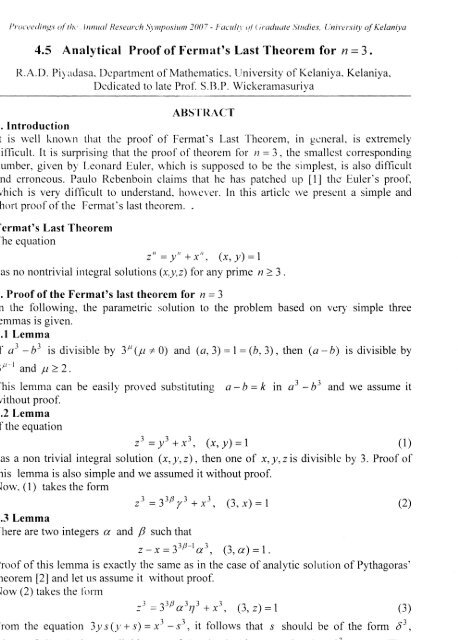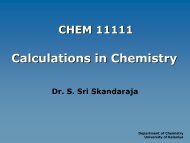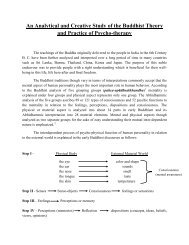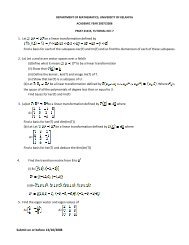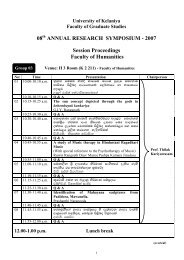4.5 Analytical Proof of Fermat's Last Theorem for n = 3.
4.5 Analytical Proof of Fermat's Last Theorem for n = 3.
4.5 Analytical Proof of Fermat's Last Theorem for n = 3.
Create successful ePaper yourself
Turn your PDF publications into a flip-book with our unique Google optimized e-Paper software.
ProC
Proceedings <strong>of</strong> the Annual Research Symposium 2007- Faculty <strong>of</strong>Gmduate Studies, University <strong>of</strong> Kelaniya<br />
Now it is clear that x -15 is divisible by three. Let us consider the expression x + y- z.<br />
x + y- z = x- (z- y) = x -15 3 . Now consider the original equation<br />
z 3 = y 3 + x 3 , (x, y) = 1 in the <strong>for</strong>m that z 3 = (x + y) (Cx + y) 2 - 3xy ). It is clear that<br />
x + y and the term, (x + y) 2 - 3xy are co-prime and there<strong>for</strong>e x + y = () 3 , where<br />
z = er; and ((), r;) = 1. Now again X+ y- z = () 3 - er; = ()(() 2 - r;) and there<strong>for</strong>e X -15 3<br />
is divisible (). x + y- z = y-(z- x) = 3fJ ary- 3 3 !3 a 3 = 3fJ a(ry- 3 2 /3-l a 2 ) and there<strong>for</strong>e<br />
x -15 3 is divisible by 3 fJ a. x is divisible by 15, which follows from ( 4) and there<strong>for</strong>e<br />
x -15 3 is divisible by 3fJ a()l5. Now consider (4) m the <strong>for</strong>m<br />
3f3+ 1 aryl5 3 ()r;=(x-15 3 Xx 2 +xl5 3 +15 9 ). From which one understands that<br />
x -15 3 = 3fJ a()l5 and since z- x = 3 3 ~-l a 3 .<br />
x = 3fJ aBI5 + 15 3<br />
y = YaBI5 + 3 3 .LJ-l a 3<br />
z = 3 3 /3-l a 3 + 3fJ aBI5 + 15 3<br />
In addition to this, we have x + y = () 3 and ('7- 3 2 /3-l a 2 ) = ()15, and there<strong>for</strong>e substituting<br />
<strong>for</strong> 17 in y , we get<br />
() 3 -15 3 - 2.<strong>3.</strong>LJ aBI5- 3 3 .LJ-t a 3 = 0 (d)<br />
There<strong>for</strong>e by lemma (1), B-15 should be divisible 3tH. Expressing 3 3 fJ- 1 a 3<br />
8.3 3 !3- 3 a 3 + 3 3 !3- 3 a 3 and () = <strong>3.</strong>LJ-t g + 15 ,we obtain from (d) that<br />
(g-2a)(15 2 +3P- 1 gi5+3 2 P- 3 (g 2 +2ag+4a 2 ))=3 2 P- 3 a 3 (5)<br />
If X = (g- 2a ), Y = (15 2 + 3/3-l gl5 + 3 2 /3-J (g 2 + 2ag )+ 4a 2 ), then it 1s clear that<br />
(3,Y) = 1,<br />
Now we prove the <strong>Fermat's</strong> last theorem <strong>for</strong> n = 3, showing that (d) is never satisfied. If<br />
a=1, g=2+3 2 .LJ-J and<br />
3,Li-l 2<br />
Y=1=(15+--g-) 2 +3 2 .LJ- 3 (_[__+2g+4) which is never<br />
2 4<br />
satisfied.<br />
Similarly , the pro<strong>of</strong> <strong>of</strong> the theorem follows when a = -1 smce f3 ~ 2 . If a 1:- 1,<br />
g = 2a. + 3 2 .LJ-J q 3 and () = 2a3P-I + (3 3 .LJ- 4 p 3 + 15). The equation (d) is <strong>of</strong> the <strong>for</strong>m<br />
() 3 -3(2.3P- 1 a)I5B-8.3 3 ,u- 3 a 3 -(3 3 P- 3 a 3 +15 3 )=0 (6)<br />
and is also <strong>of</strong> the <strong>for</strong>m.<br />
x 3 - <strong>3.</strong>u.vx- u 3 - v 3 = 0 and there<strong>for</strong>e we can make use <strong>of</strong> the well known method <strong>of</strong><br />
Tatagliya and Cardon (see[3] ).Then u 3 must be a solution <strong>of</strong> the quadratic<br />
x 2 + Gx - H 3 = 0 and the roots <strong>of</strong> (d) <strong>for</strong> ()are u + v, u UJ + v UJ 2 , u UJ 2 + v UJ , where UJ is<br />
the cube root <strong>of</strong> unity. It can be easily shown that this occurs only if u = 0. which gives<br />
a = 0 and this corresponds to the trivial solution x.y.z = 0 .Hence the pro<strong>of</strong> <strong>of</strong> the<br />
theorem.<br />
References:<br />
1) Paulo Ribenboim, Fermat;s last theorem <strong>for</strong> amateurs, Springer 1991.<br />
2) Piyadasa R.A.D. & Karunatileke N .G.A., 10 111 International Conference <strong>of</strong> Sri Lanka<br />
Studies Abstract pp 108, 2005.<br />
3)Archfold J.W. Algebra SirlssacPitman&Sons,LTDLondon,,pp.174, 1961.<br />
128<br />
(a)<br />
(b)<br />
(c)<br />
as


